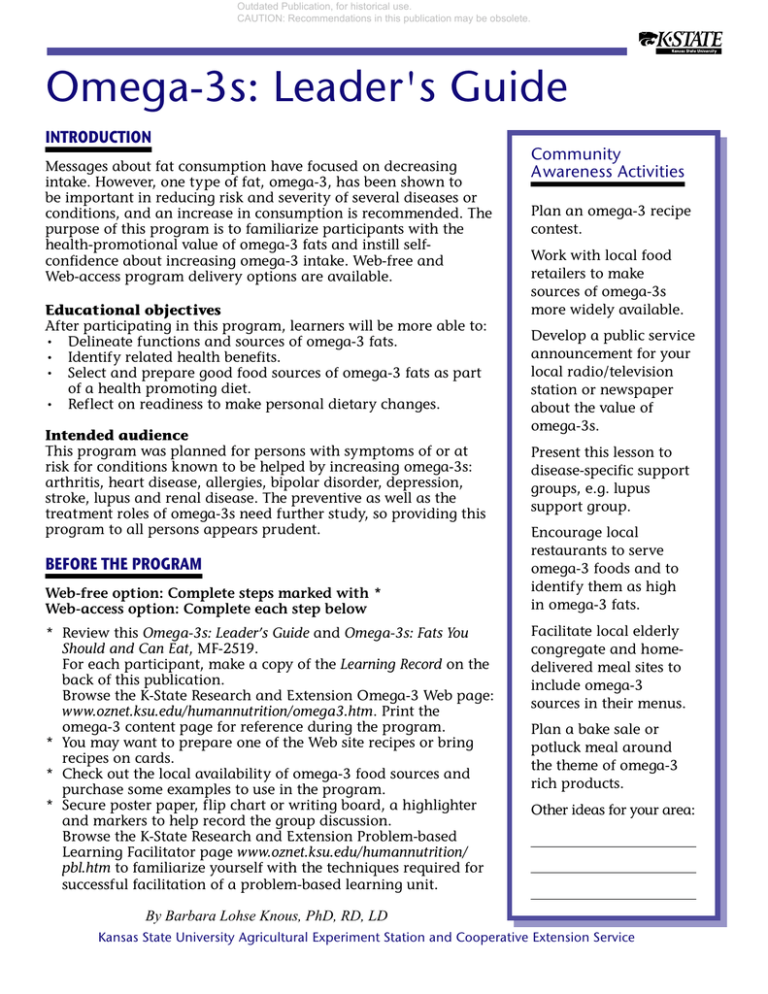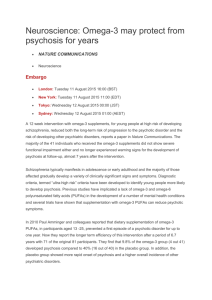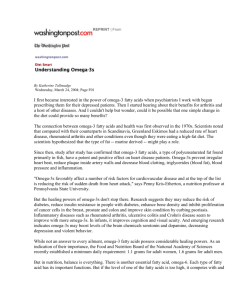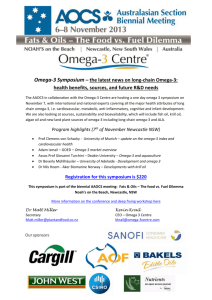
Outdated Publication, for historical use.
CAUTION: Recommendations in this publication may be obsolete.
Omega-3s: Leader's Guide
INTRODUCTION
Messages about fat consumption have focused on decreasing
intake. However, one type of fat, omega-3, has been shown to
be important in reducing risk and severity of several diseases or
conditions, and an increase in consumption is recommended. The
purpose of this program is to familiarize participants with the
health-promotional value of omega-3 fats and instill selfconfidence about increasing omega-3 intake. Web-free and
Web-access program delivery options are available.
Educational objectives
After participating in this program, learners will be more able to:
• Delineate functions and sources of omega-3 fats.
• Identify related health benefits.
• Select and prepare good food sources of omega-3 fats as part
of a health promoting diet.
• Reflect on readiness to make personal dietary changes.
Intended audience
This program was planned for persons with symptoms of or at
risk for conditions known to be helped by increasing omega-3s:
arthritis, heart disease, allergies, bipolar disorder, depression,
stroke, lupus and renal disease. The preventive as well as the
treatment roles of omega-3s need further study, so providing this
program to all persons appears prudent.
BEFORE THE PROGRAM
Web-free option: Complete steps marked with *
Web-access option: Complete each step below
* Review this Omega-3s: Leader’s Guide and Omega-3s: Fats You
Should and Can Eat, MF-2519.
For each participant, make a copy of the Learning Record on the
back of this publication.
Browse the K-State Research and Extension Omega-3 Web page:
www.oznet.ksu.edu/humannutrition/omega3.htm. Print the
omega-3 content page for reference during the program.
* You may want to prepare one of the Web site recipes or bring
recipes on cards.
* Check out the local availability of omega-3 food sources and
purchase some examples to use in the program.
* Secure poster paper, flip chart or writing board, a highlighter
and markers to help record the group discussion.
Browse the K-State Research and Extension Problem-based
Learning Facilitator page www.oznet.ksu.edu/humannutrition/
pbl.htm to familiarize yourself with the techniques required for
successful facilitation of a problem-based learning unit.
Community
Awareness Activities
Plan an omega-3 recipe
contest.
Work with local food
retailers to make
sources of omega-3s
more widely available.
Develop a public service
announcement for your
local radio/television
station or newspaper
about the value of
omega-3s.
Present this lesson to
disease-specific support
groups, e.g. lupus
support group.
Encourage local
restaurants to serve
omega-3 foods and to
identify them as high
in omega-3 fats.
Facilitate local elderly
congregate and homedelivered meal sites to
include omega-3
sources in their menus.
Plan a bake sale or
potluck meal around
the theme of omega-3
rich products.
Other ideas for your area:
By Barbara Lohse Knous, PhD, RD, LD
Kansas State University Agricultural Experiment Station and Cooperative Extension Service
Outdated Publication, for historical use.
CAUTION: Recommendations in this publication may be obsolete.
Omega-3s: Leader's Guide
Web-free option
If you do not have Web access, guide participants through the lesson, then complete the Ask
Yourself and Examine Your Food Choices activities in fact sheet MF-2519.
Web-access option
1. Indicate to participants that the program on omega-3s will be conducted using a small
group, participatory format.
2. Provide each participant with fact sheet MF-2519. Briefly outline the sections of the lesson.
Distribute copies of The Learning Record, found on the back page of this leader's guide.
3. Plan to have either a participant or you read aloud Jim’s Health Concern, also on the back page.
4. Divide the group into small groups. Assign each group a number to record on their Learning
Record. Let participants work in small groups to apply the lesson information to Jim’s problem.
5. Ask the small groups to list on the Learning Record requests for additional information that
would help them give advice to Jim. You may need to give examples, e.g. “Does Jim have any
food allergies?” Use the Problem Data (at right) to provide each group with answers to their
questions. Each small group may ask different questions; that is OK. At the end of the program,
participants will be able to learn from the unique approach of each small group.
Follow documentation directions on the Problem Data page.
6. As a larger group, discuss the advice each small group planned to give Jim.
7. Next, encourage participants to identify new knowledge and new or continuing questions
raised by this program; have them record these on the Learning Record. Collect and mail
completed Learning Records to:
Barbara Lohse Knous, PhD RD LD, Kansas State University, 203 Justin Hall, Manhattan, KS 66506.
8. Now help participants apply the lesson information to themselves by having them complete
the Ask yourself and Examine your choices activities found in MF-2519 Omega-3s: Fats You Should
and Can Eat. Discuss their answers as a larger group. Review lesson information not covered or
discussed by the small groups. Encourage browsing of the K-State Omega-3 Web site.
References used to prepare
this lesson are cited on the
K-State Research and
Extension Omega-3 Web site:
www.oznet.ksu.edu/
humannutrition/omega3.htm.
The shaded regions denote the structural difference
between omega-6 (top) and omega-3 (bottom) fatty acids.
– figure by Judy Speer, graphic designer, Department of Human Nutrition
Program leaders will want to
contact an RD or MD to
answer questions or provide
information about medical
nutrition therapy.
Outdated Publication, for historical use.
CAUTION: Recommendations in this publication may be obsolete.
Omega-3s: Leader's Guide
Problem Data (for use with the Web-access option)
Using a highlighter, mark the facts that participants request. If an item is requested by more than
one group, then use a pen to circle or underline the already highlighted item.
Age: 53
Height: 5’10’’
Health:
Weight: 208 pounds
Mild heart attack six months ago. History of some depression, but
has never visited a counselor or used medication for this.
Current supplement usage: 400 IU vitamin E; multivitamin; heart combo of B6, B12 and folate
Medications:
Aspirin, 1/2 tablet a day
Alcohol and tobacco use:
Smoked 1/2 pack per day for 30 years until six months ago.
Drinks two or three glasses of wine occasionally, but no more
than weekly.
Food allergies:
Shrimp
Food preferences:
Jim likes all foods; no dislikes noted
Exercise:
No participation in a exercise program; aware of need to be active
•
Background:
Accountant; married, two grown children; golfs, gardens, reads
Facilitator Survey:
Please complete the survey and mail this entire page with the participants’ Learning Records to:
Barbara Lohse Knous, PhD RD LD, Kansas State University, 203 Justin Hall, Manhattan, KS 66506.
Lesson used
__ First time
__ 2 - 5 times
__ >5 times
The format used for the omega-3 FACS lesson was:
Enjoyable
1
2
3
4
Challenging
1
2
3
4
(Please circle the number that most closely agrees with your opinion.)
The content of the omega-3 FACS lesson was:
Useful
1
2
3
4
Understandable
1
2
3
4
Beneficial to me
1
2
3
4
(Please circle the number that most closely agrees with your opinion.)
5
5
5
5
5
6
6
6
6
6
7
7
7
7
7
Frustrating
Simple
Not useful
Confusing
Not beneficial
Check the statement that best describes your opinion.
_ _ I plan to use this small group format with this lesson again.
__ I plan to use the lesson, but modify the format. (Explain.)
__ I will probably not use this lesson again. (Explain.)
Approximately how much time did you spend preparing for this program?
____ Minutes
Outdated Publication, for historical use.
CAUTION: Recommendations in this publication may be obsolete.
Learning Record:
Group # __
Date _________
Coun ty ________
Jim’s Health Concern
Jim was diagnosed six months ago with rheumatoid arthritis and has been
feeling very depressed lately. A friend told him about a study that had used
cod liver oil to help depression and arthritis. Jim already takes some medications, so he is reluctant to try another supplement, especially ones that would
increase his fat intake. However, he would like to try some dietary changes if
this treatment is helpful. Jim is really uncertain about his choices.
Information requests
Advice for Jim
Identify some facts you learned by studying about Jim’s problem.
What new questions have been raised by your study of this situation?
Please circle the number that most closely agrees with your opinion.
I learned a lot
1
2
3
4
5
I learned very little
I would like to study
more topics using this
small group format
1
2
3
4
5
I prefer to use another
method to study
this topic
I found this learning
format enjoyable
1
2
3
4
5
The format was not
enjoyable to me
Comments:
Please mail to Barbara Lohse Knous, Kansas State University, 203 Justin Hall, Manhattan, KS 66506.
Publications from Kansas State University may be freely reproduced for educational purposes. All other rights reserved. In either case,
credit Barbara Lohse Knous, Omega-3s: Leader's Guide, Kansas State University, August 2001.
Kansas State University Agricultural Experiment Station and Cooperative Extension Service, Manhattan, Kansas
MF-2520
AUGUST 2001
It is the policy of Kansas State University Agricultural Experiment Station and Cooperative Extension Service that all persons shall have equal
opportunity and access to its educational programs, services, activities, and materials without regard to race, color, religion, national origin, sex, age
or disability. Kansas State University is an equal opportunity organization. Issued in furtherance of Cooperative Extension Work, Acts of May 8 and
June 30, 1914, as amended. Kansas State University, County Extension Councils, Extension Districts, and United States Department of Agriculture
Cooperating, Marc A. Johnson, Director.





